Ground covers add beauty to the garden at ground level and keep the surrounding area cool, as they help prevent the ground from heating up during hot summers. The low-growing Southwestern favorites below attract native pollinators, such as birds and bees, and keep weeds to a minimum underneath their outreaching stems. Whether you live in a small bungalow, an adobe home or a ranch-style house, any of these native drought-tolerant ground covers would benefit your home and garden.
Not in the Southwest? Browse plants native to more regions of the U.S.
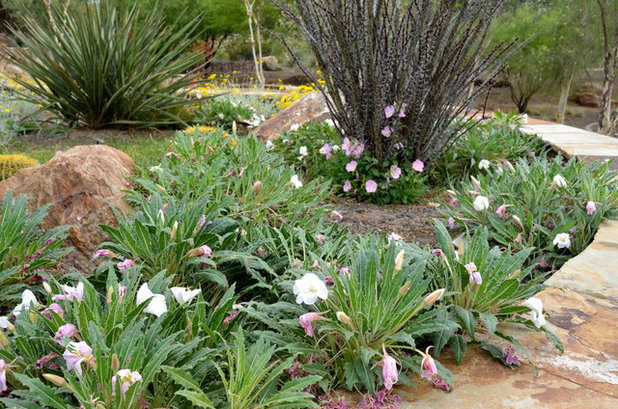
Noelle Johnson Landscape Consulting
1. Tufted Evening Primrose(
Oenothera caespitosa)
Native to the higher-elevation regions (above 4,500 feet) of the western United States and Canada
At dusk the show begins when large white flowers unfurl their petals over dark green foliage. The lightly fragrant blossoms attract nighttime pollinators and last through the morning. Each flower lasts one day, fading to a delicate shade of pink.
Plant tufted evening primrose where you can enjoy the 4-inch-wide blooms in the evening and morning. It has a long bloom period, beginning in spring and lasting through late summer.
Where it will grow: Hardy to minus 20 degrees Fahrenheit, or minus 28.9 degrees Celsius (USDA Zone 5; find your zone)
Water requirement: Low to moderate
Light requirement: Full sun (filtered shade in low-desert zones)
Mature size: 1 foot tall and 2 to 3 feet wide
See how to grow tufted evening primrose
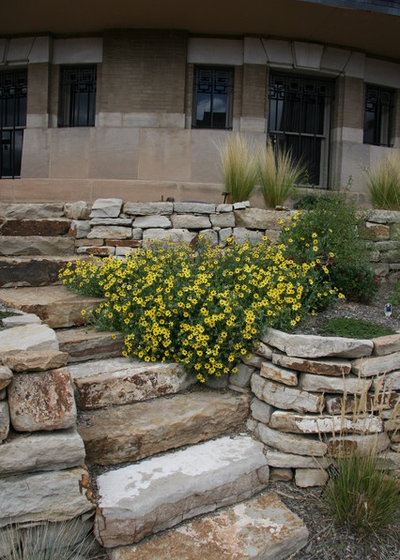
Plant Select®
2. Lyreleaf Greeneyes(
Berlandiera lyrata)
Native to the Central Plains and southwestern United States
The mouthwatering scent of chocolate is present wherever this yellow-flowering perennial is planted. In addition to its delicious aroma, it produces attractive yellow flowers with maroon centers from spring through fall.
Because its fragrance is most intense in the morning, plant lyreleaf greeneyes, also called chocolate flower, wherever you spend time in the morning and where you can enjoy both the fragrance and the butterflies that come to visit. Prune back in late winter to rejuvenate.
Where it will grow: Hardy to minus 25 degrees Fahrenheit, or minus 31.7 degrees Celsius (zones 4 to 9)
Water requirement: Low; some supplemental water is required in low-desert regions
Light requirement: Full sun (filtered shade in low-desert zones)
Mature size: 12 to 14 inches tall and 12 to 16 inches wide
See how to grow lyreleaf greeneyes
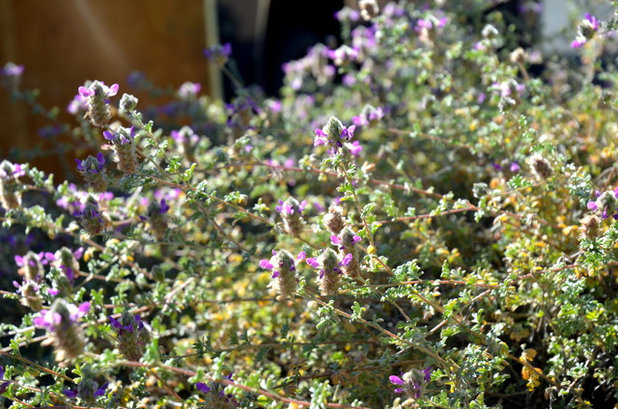
Noelle Johnson Landscape Consulting
3. Trailing Indigo Bush(
Dalea greggii)
Native to Texas and Mexico
Lacy gray-green foliage provides great color and textural contrast throughout the year. Trailing indigo bush has a softly mounded growth habit and is covered with light purple flowers in spring, creating a subtle brush of color in the landscape.
This Texas native thrives in full sun and can handle areas near sidewalks or streets that receive reflected heat. Its stems root wherever they touch soil, helping it to spread up to 6 feet wide.
Where it will grow: Hardy to 10 degrees Fahrenheit, or minus 18 degrees Celsius (Zone 7)
Water requirement: Low to moderate
Light requirement: Full, reflected sun
Mature size: 1 foot to 2 feet tall and 2 to 6 feet wide
See how to grow trailing indigo bush
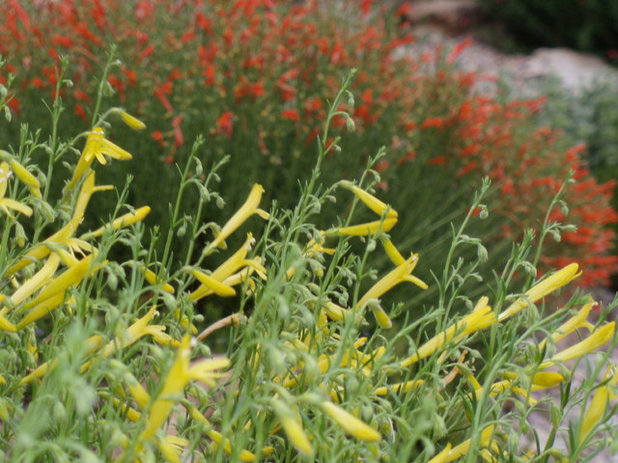
Waterwise Landscapes Incorporated
The yellow variety of pineleaf penstemon, ‘Mersea Yellow’, with the more common orange variety in the background.
4. Pineleaf Penstemon(
Penstemon pinifolius)
Native to Arizona, New Mexico and Mexico
As its name suggests, this spreading ground cover gets its name from bright green foliage that resembles that of a pine tree. Small, tubular orange flowers appear in summer, much to the delight of hummingbirds.
Found in the forests of the Southwest, pineleaf penstemon is extremely cold-hardy while also being able to handle temperatures over 100 degrees Fahrenheit.
Where it will grow: Hardy to minus 30 degrees Fahrenheit, or minus 34.4 degrees Celsius (zones 4 to 9)
Water requirement: Low
Light requirement: Full sun (filtered shade in low-desert zones)
Mature size: 2 feet tall and wide
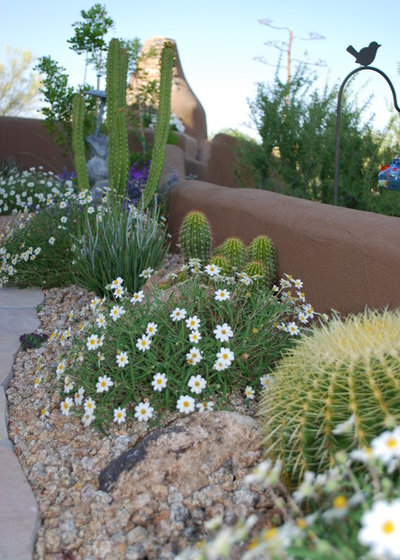
Pascale Land Design
5. Blackfoot Daisy(
Melampodium leucanthum)
Native to the Central Plains, southwestern United States and northern Mexico
The sight of white daisies brightens anyone’s day, and those on this native ground cover certainly don’t disappoint. Dark green foliage is dotted with 1-inch-wide daisies, whose white petals and golden yellow centers add welcoming color to the Southwest’s garden palette.
Don’t let the delicate appearance of the flowers fool you — intense heat and cold winters don’t bother blackfoot daisy. Flowers appear in spring and fall in low-desert zones; it waits until summer to bloom in higher elevations.
Where it will grow: Hardy to minus 20 degrees Fahrenheit, or minus 28.9 degrees Celsius (Zone 5)
Water requirement: Low
Light requirement: Full, reflected sun (filtered shade in low-desert zones)
Mature size: 12 inches tall and18 inches wide
See how to grow blackfoot daisy

Noelle Johnson Landscape Consulting
6. Damianita(
Chrysactinia mexicana)
Native to the high desert regions of Arizona, Utah, Colorado, New Mexico, Texas and Mexico
This ground cover is rather unassuming when it’s not in flower and serves nicely as a dark green backdrop. The dark green leaves are small and needle-like.
Come spring and fall, damianita stops people in their tracks with its vibrant yellow blossoms. The intensely colored flowers almost entirely cover its aromatic foliage.
Where it will grow: Hardy to 0 degrees Fahrenheit, or minus 17.8 degrees Celsius (Zone 7)
Water requirement: Low
Light requirement: Full sun
Mature size: 1 foot to 2 feet tall and 2 feet wide
See how to grow damianita
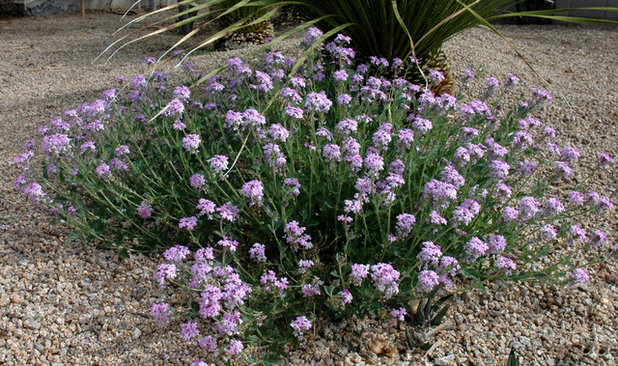
Noelle Johnson Landscape Consulting
7. Southwestern Mock Vervain(
Glandularia gooddingii)
Native to the desert Southwest, including Arizona, California, Nevada, Utah, New Mexico, Colorado, Oklahoma, Texas and the Mexican states of Baja California and Sonora
Southwestern mock vervain produces pale pink to lavender flowers that decorate the drought-tolerant garden. Butterflies flock to these flowers, which appear in winter and spring in low-desert zones and in spring and summer in higher zones.
The gray-green color of the leaves and stems comes from tiny white hairs that help reflect the sun’s rays. Although short-lived, southwestern mock vervain does self-seed, making sure that there are plants ready to grow in its place.
Where it will grow: Hardy to 0 degrees Fahrenheit, or minus 17.8 degrees Celsius (Zone 7)
Water requirement: Low to moderate
Light requirement: Full sun
Mature size: 1 foot tall and up to 3 feet wide
See how to grow southwestern mock vervain
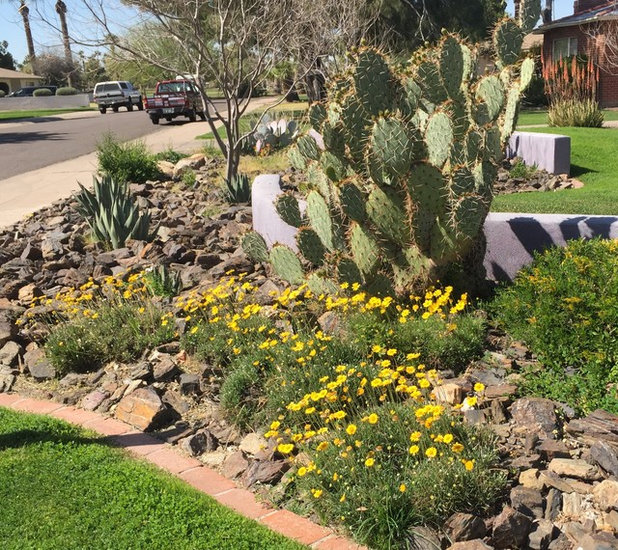
Noelle Johnson Landscape Consulting
8. Angelita Daisy(
Tetraneuris acaulis)
Native throughout the western United States and into Canada
In areas with mild winters — Zone 8 and above — this small perennial blooms nearly continuously, providing much-needed color in winter as well as throughout the rest of the year. In colder zones, it blooms from late spring into early fall. Extremely cold- and heat-tolerant, angelita daisy looks best when planted along an entry path or next to boulders, where its yellow flowers add a welcoming splash of color.
Despite its delicate appearance, angelita daisy is quite tough and thrives in full sun. It does self-seed and can be allowed to spread to create a ground cover with a natural wildflower look.
Where it will grow: Hardy to minus 20 degrees Fahrenheit, or minus 28.9 degrees Celsius (Zone 5)
Water requirement: Low
Light requirement: Full sun
Mature size: 1 foot tall and wide
See how to grow Angelita daisy
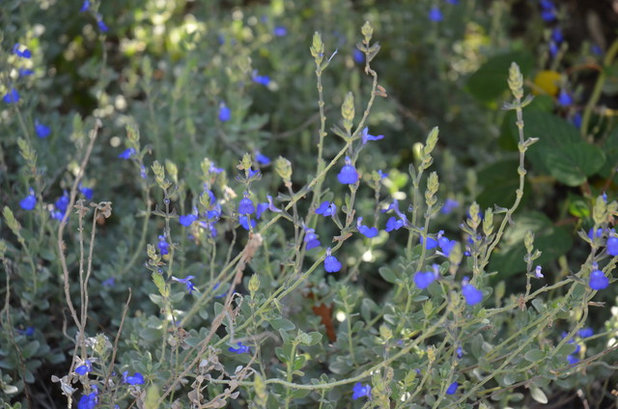
Noelle Johnson Landscape Consulting
9. Germander Sage(
Salvia chamaedryoides)
Native to the Chihuahuan Desert region
The vibrant blue flowers of germander sage capture the attention of passersby and hummingbirds. The color blue is often not well-represented in the garden, due to a lack of blue-flowering plants, which makes this flowering ground cover well worth adding for its colorful blossoms alone.
Its gray-green foliage provides the perfect backdrop for the small yet vivid blue flowers, which appear primarily in spring and fall.
Where it will grow: Hardy to 15 degrees Fahrenheit, or minus 9.4 degrees Celsius (Zone 8)
Water requirement: Low
Light requirement: Full sun to partial shade (filtered shade is best in low-desert zones)
Mature size: 1 foot to 2 feet tall and 2 to 3 feet wide
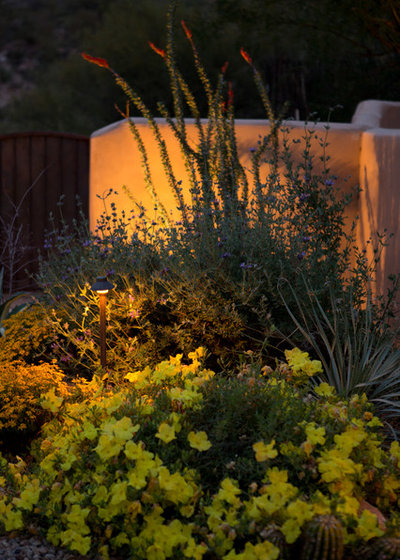
Landscape Design West, LLC
10. Hartweg’s Sundrops(
Calylophus hartwegii)
Native to Arizona, New Mexico, Texas and Mexico
The warm weather of spring finds this ground cover covered in large yellow flowers, which last a single day before fading to an attractive shade of pale orange with a touch of pink. Blooming lasts through the summer and on into early fall. The flowers open at night and fade in the late afternoon.
Its narrow leaves add a pleasant bright green spot of color and look great next to boulders, along steps or planted in raised beds where they can trail over the edge. Prune back to 6 inches in early spring to rejuvenate and remove woody growth.
Where it will grow: Hardy to minus 20 degrees Fahrenheit, or minus 28.9 degrees Celsius (Zone 5)
Water requirement: Low
Light requirement: Full sun
Mature size: 12 to 18 inches tall and 2 feet wide





